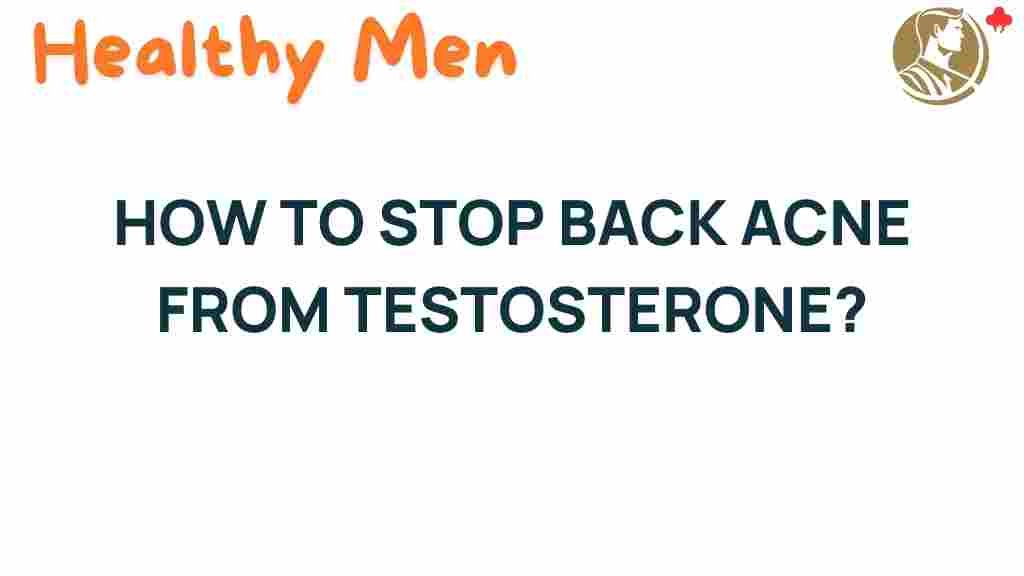Unveiling the Connection: How Testosterone Triggers Back Acne
Back acne, often referred to as “bacne,” can be a source of frustration and self-consciousness for many individuals. One of the primary culprits behind this condition is testosterone, a hormone that plays a significant role in our body’s overall health. Understanding how testosterone triggers back acne can help you develop effective skincare routines, treatments, and preventive measures. In this article, we will explore the connection between testosterone and back acne, delve into the science behind hormonal acne, and provide actionable tips for treatment and prevention.
Understanding Testosterone and Its Role in the Body
Testosterone is an essential hormone found in both men and women, albeit in different amounts. It is primarily produced in the testes in men and in the ovaries and adrenal glands in women. This hormone is crucial for various bodily functions, including:
- Regulating libido and sexual function
- Contributing to muscle mass and strength
- Influencing mood and energy levels
- Maintaining bone density
However, fluctuations in testosterone levels can lead to significant changes in the body’s systems, including skin health. Elevated levels of testosterone can increase sebum production, which can clog pores and lead to acne, particularly on the back.
The Science Behind Back Acne
Back acne, like other forms of acne, is primarily caused by the accumulation of oil, dead skin cells, and bacteria in the pores. When testosterone levels rise, the sebaceous (oil) glands become more active, producing excess oil. This process can lead to:
- Clogged pores
- Inflammation
- Increased risk of bacterial growth
As a result, hormonal acne, including back acne, can occur. It’s essential to note that hormonal fluctuations can be influenced by various factors, including puberty, menstrual cycles, pregnancy, and certain medical conditions.
Identifying the Symptoms of Back Acne
Back acne can manifest in several ways. Recognizing the symptoms is crucial for effective treatment. Common signs of back acne include:
- Small red bumps or pimples on the back
- Inflamed cysts or nodules
- Painful, tender spots
- Scarring or dark spots after blemishes heal
If you notice these symptoms, it’s essential to take action to prevent further outbreaks and manage existing acne.
Effective Skincare for Back Acne
Skincare plays a vital role in managing back acne. Here are some effective strategies for incorporating into your body care routine:
- Choose Non-Comedogenic Products: Look for body washes, moisturizers, and sunscreens labeled as non-comedogenic, meaning they won’t clog pores.
- Exfoliate Regularly: Use gentle exfoliating scrubs or chemical exfoliants containing salicylic acid or glycolic acid to remove dead skin cells and prevent clogged pores.
- Shower After Sweating: Always shower after exercising or sweating to remove excess oil and dirt from your skin.
- Wear Breathable Fabrics: Choose loose-fitting, breathable clothing to minimize sweating and irritation on your back.
Hormonal Acne Treatments
When it comes to treating back acne, especially hormonal acne triggered by testosterone, several options are available:
- Topical Treatments: Over-the-counter products containing benzoyl peroxide or salicylic acid can help reduce inflammation and clear up acne.
- Prescription Medications: For severe cases, dermatologists may prescribe topical retinoids or oral medications like antibiotics or hormonal treatments.
- Hormonal Therapy: Birth control pills can help regulate hormone levels in women, potentially reducing hormonal acne flare-ups.
- Isotretinoin: In cases of severe acne, isotretinoin may be recommended as a last resort to reduce oil production.
Preventing Back Acne
Preventive measures can significantly reduce the occurrence of back acne. Here are some effective strategies:
- Maintain a Healthy Lifestyle: A balanced diet rich in fruits, vegetables, and healthy fats can help regulate hormone levels.
- Stay Hydrated: Drinking plenty of water helps keep your skin hydrated and can reduce oiliness.
- Manage Stress: High-stress levels can lead to hormonal fluctuations. Consider practices such as yoga, meditation, or deep breathing exercises to manage stress effectively.
- Regular Exercise: Exercise improves circulation and promotes healthy skin, but ensure to shower afterward to remove sweat.
Troubleshooting Tips for Persistent Back Acne
If you find that your back acne persists despite following a skincare routine and preventive measures, consider the following troubleshooting tips:
- Consult a Dermatologist: If over-the-counter treatments are ineffective, a dermatologist can provide personalized recommendations.
- Evaluate Your Diet: Identify any food sensitivities or allergies that may be contributing to your acne.
- Review Your Hair Care Products: Some shampoos and conditioners can cause acne if they come into contact with your back. Consider switching to non-comedogenic formulas.
- Keep Your Bedding Clean: Wash your sheets and pillowcases regularly to reduce bacteria and oil transfer onto your skin.
Conclusion: Embracing Healthy Skin
Understanding the connection between testosterone and back acne is crucial for effective treatment and prevention. By adopting a comprehensive skincare routine, maintaining a healthy lifestyle, and seeking appropriate treatments, you can manage and prevent back acne effectively. Remember, consistency is key, and it may take time to see significant improvements.
If you are struggling with persistent back acne, don’t hesitate to consult a dermatologist for professional advice tailored to your specific needs. Embrace the journey towards healthier skin and boost your confidence in your body care routine!
For more information on skincare and health, check out this resource.
This article is in the category Conditions and created by healthymen Team
